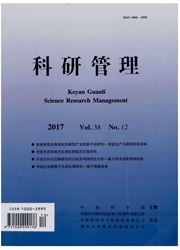

 中文摘要:
中文摘要:
基于2005—2009年广东省部产学研合作的面板数据,应用超越对数随机前沿模型测评了260家合作企业的创新效率,并基于系统视角考察了影响合作创新效率的关键因素。实证结果表明,样本期内产学研合作创新效率处于偏低但稳步提升的状态;系统内关键因素的作用路径与效果存在差异性,其中,企业家精神、外部技术依存和政府资助对合作效率有显著的正向影响,且政府资助的影响效果具有长效性,出口导向与合作模式对合作效率有显著的负向影响,且出口导向的非效率影响程度更高,而行业差异对合作效率的影响未通过显著性检验。最终,结合相关理论与实践对结果进行讨论,并指出研究局限和未来研究方向。
 英文摘要:
英文摘要:
Based on the panel data of the Industry -University- Research institution Collaboration (IURC) in Guangdong Prov- ince from 2005 to 2009, the innovation efficiency of 260 companies is empirically evaluated using the stochastic frontier model, and the key factors influencing IURC efficiency are researched from the system perspective. The results show that the cooperative innovation efficiency in the sample period is still low but is steadily increasing; the influence effect and path are diverse among key -factors in the system. Entrepreneurship, external technology dependency, and government subsidy have a significantly posi- tive effect on ]URC efficiency, among them government subsidy has a long - acting effect on it; the cooperation pattern shows a significant negative impact on IURC efficiency, while export orientation has a higher non - efficiency impact degree. The impact of industry differences on IURC efficiency is unable to pass the significance test. Finally, the limitations and future directions are discussed according to the related theory and practice.
 同期刊论文项目
同期刊论文项目
 同项目期刊论文
同项目期刊论文
 期刊信息
期刊信息
